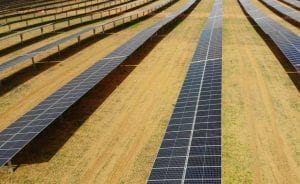The Murdoch media campaign against climate policies and renewables plumbed new depths on Thursday, with a front page lead story in The Australian promoting patently absurd costings that were quickly endorsed by the Coalition government as “proof” of the dangers of Labor’s proposed energy and climate policies.
The Australian newspaper , two days after publishing a grossly misleading front page lead on the cost to households of rooftop solar rebates, said a report by Brian Fisher of BAEconomics suggested the “cumulative economic losses” from Labor’s 50 per cent renewables target and 45 per cent emissions target would be $472 billion.
The story was quickly embraced by the Coalition government, with energy minister Angus Taylor saying it was “further proof” that under a Bill Shorten Labor government, Australians will be poorer, and that even a 50 per cent renewables target would be a “wrecking ball” through the economy.
To highlight the absurdity of that stance, Taylor appears to have ignored the fact that Fisher’s analysis claimed that the Coalition’s own emissions target – of 26-28 per cent by 2030 that the government says will be met “in a canter” and at little cost – would actually cost around $70 billion.
Just a week ago, Taylor was hailing a separate report from ANU that said Australia would meet its emissions target early and at no extra cost.
The Australian sought to paint Fisher as some sort of “middle-man”, straddling both sides of politics and acting as an advisor on climate policy to both Labor and Coalition governments.
The former ahead of ABARE has form, and has been a relentless campaigner against climate action and renewable energy policies for decades, and his private firm has produced many equally improbable reports for the fossil fuel lobby, and in particular the Minerals Council, who supplied prime minister Scott Morrison with the lump of coal he infamously waved around parliament, and whose former deputy CEO now serves as Morrison’s chief of staff.
Fisher was also hand-picked by Tony Abbott to sit on the “RET Review” panel that he hoped would lead to the scrapping of the renewables target – a mechanism that was not scrapped and which is now credited with the investment boom in wind and solar that is likely to take Australia within several short hops of Labor’s 50 per cent target.
As Origin Energy underlined on Thursday, new projects are now being contracted at prices vastly lower than the current wholesale price – set almost uniquely by black coal and gas plants – indicating that they are being developed without subsidies. The futures price of large-scale certificates reflects this.
Fisher’s estimates are based on the assumption that wind and solar and storage cost more, but this flies against all other serious analysis. AGL has said repeatedly that renewables and storage is cheaper even than trying to extend the life of ageing generators like Liddell, and says the argument over costs on renewables versus new coal was lost long ago.
If further evidence was needed, the CSIRO and the Australian Energy Market Operator released a report late last year that also concluded that wind and solar, backed by either battery or pumped hydro storage, was clearly cheaper than new coal plants.
Tristan Edis, from Green Energy Markets and a veteran policy analyst, says Fisher has been wrong about technology costs for a very long time. In 2006, Edis says, Fisher co-authored a report that suggested coal and gas would remain cheaper than “non hydro renewables” such as wind or solar until 2050.
It assumes that wind and solar may nearly halve their costs over the 50 year period considered. Instead, in just over a decade, solar has slashed its costs by 90 per cent and wind by more than 50 per cent.
This is what the CSIRO recently concluded were the current prices of various energy sources, with wind and solar at half the cost of coal and gas.
“New coal is about twice as expensive as wind and solar,” Edis notes.
“New gas is at least 30 per cent more expensive and potentially twice as expensive as wind and solar. Given (Fisher)’s track record I wonder why The Australian thinks his predictions are worthy of front page news.”
He noted another report by Fisher in 2012, for the oil and gas lobby, also called for the RET to be scrapped because gas would provide cheaper abatement. That prediction has not worked out so well.
But government ministers were out in force on Thursday embracing the Australian story, downplaying Glencore’s commitment for no new coal mines, saying it was an endorsement of their decision to do little on climate and energy.
 Resources Minister Matt Canavan, who now proudly includes a logo from a privately owned coal company on his Twitter handle, joined Taylor to dismiss Glencore’s move as “self-serving nonsense” and later said it was about the “European antipathy to coal”.
Resources Minister Matt Canavan, who now proudly includes a logo from a privately owned coal company on his Twitter handle, joined Taylor to dismiss Glencore’s move as “self-serving nonsense” and later said it was about the “European antipathy to coal”.
As for Fisher’s report, he described it as “data” that showed “what would happen if a Labor government came in and pushed a unilateral target of a 45 per cent reduction in carbon emissions.”
Canavan then went on to describe the threats to refineries and smelters in regions, ignoring the fact that zinc refiner SunMetals in far north Queensland sees solar as the basis of its future, as does Sanjeev Gupta in the revitalisation of the Whyalla Steelworks that would likely have closed without a commitment to green energy.
Rod Campbell, policy director at The Australia Institute, says Fisher’s record was often ignored by media, and conveniently so by the Coalition government.
“BAEconomics have put out some outrageous things for the Minerals Council on the supposed costs of the RET, and have been spruiking for coal mines,” Campbell told RenewEconomy, whose readers may be familiar with Fisher’s record in past stories .
“If you are going to roll out a modelling report – effectively a four page rant – and yet somehow you get a front page story with the word ‘apocalypse’ – I think we’ve reached peak stupid for economic modelling,” Campbell said.
Note: The Australian, as far as we can tell, has yet to correct its story on rooftop solar, despite it being reproduced cross the Murdoch media empire, and in free-to-air TV, talkback radio and climate denialist blogs.
But on Thursday, the paper did write an editorial calling for the end to rooftop solar rebates, describing them as “government incentives for the wealthy or ideologically inclined”.
It did not repeat its false claim that the rebates would cost $195 a year (actually only about $34), offering only: “Renewable energy spruikers might quibble, claiming the cost benefits of renewables should be taken into account.”
Incidentally, Fisher also called for the scrapping of rooftop solar subsidies way back in 2014. About the same time, as we reported, that he availed himself of the subsidy for his hobby farm near Canberra.










